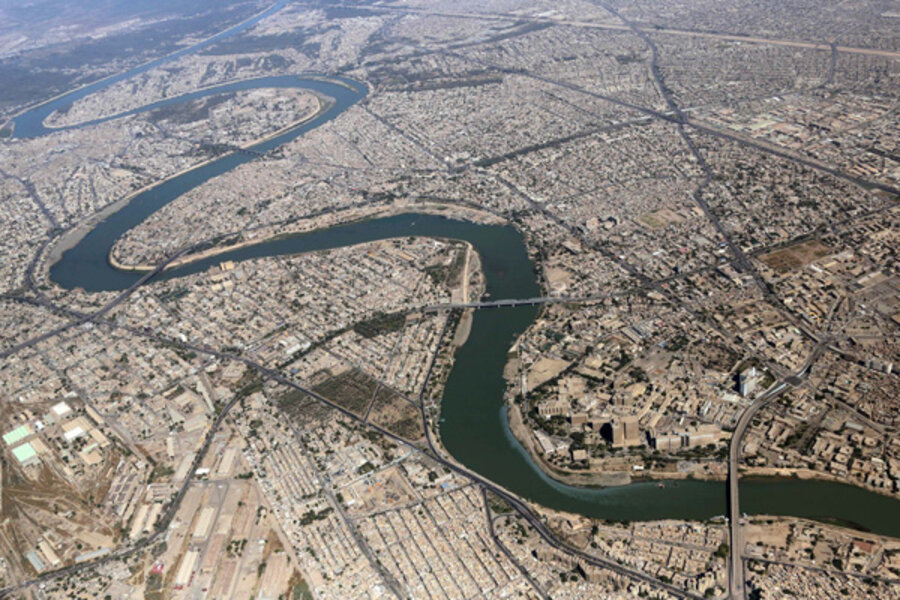Dammed, dirty, drained by war: can Iraq's Tigris River be restored?
Loading...
| Faysh Khabur, Iraq
Fifty years ago, wooden rafts called keleks regularly plied the Tigris River, carrying people, livestock, and cargo – with loads up to 35 tons – from southern Turkey to northern Iraq. Built from logs lashed together and made buoyant by inflated goat skins, a fully loaded kelek could travel the 250-mile distance from Diyarbakır, Turkey, to Mosul, Iraq, in just six days.
Today, the rafts' long, heavy wooden oars push slowly through the brown, flat waters of the Tigris as they traverse northern Iraq. Sometimes their bottoms scrape the riverbed, the water levels low enough on a late September day for a tall man to stand waist-deep in the middle of the river. It takes a full day of hard effort to row eight miles.
Heavily dammed and diverted, the Tigris has “lost many of the qualities of a natural river,” says Jantine van Herwijnen, the outreach coordinator for Nature Iraq. To draw attention to the river's plight, the Sulaimaniyah-based environmental group has been taking a kelek and two other traditional Mesopotamian vessels—the basket-like guffa and the canoe-like tarada—on a 750-mile journey down the embattled waterway, bordered by steep and craggy terrain on one side, rolling and golden landscape on the other.
Though the original plan for the Tigris River Flotilla had been to row, paddle, and float the entire way, dams and other blockages on the Tigris, security concerns, and visa and permit hassles have periodically forced the group to load its boats onto trucks and skirt the most difficult portions of the river. Similar problems likewise have stymied attempts to protect the Tigris. Protection of this river, one of two that gave life to ancient Mesopotamia (which means "land between two rivers") and remains crucial to watering modern Iraq, has taken a backseat in Baghdad, according to Nature Iraq founder Azzam Alwash.
The Iraqi-born, US-educated engineer has been working since 2003 to revitalize the marshlands of southern Iraq, which lie at the intersection of the Tigris and Euphrates rivers. This year, his efforts yielded a Goldman Environmental Prize, whose $150,000 award is funding the flotilla, and the designation of the marshes as Iraq’s first national park.
Ninety percent of the marshes, a rare desert wetland, were drained in the 1990s by diversion projects that Saddam Hussein ordered to thwart and punish political opponents. Though the marsh ecosystem has made a striking recovery, it is starting to shrink again due to pressures on the river’s water from Turkey, Syria, and Iraq itself, according to Shirouk Abayachi, a senior adviser for the Iraqi Ministry of Water Resources.
“Iraq is downstream, so we are very vulnerable to what is being done in neighboring countries. We can only save the life of the Tigris if we manage it as a whole system on the national and regional level,” Mr. Abayachi says.
The Tigris River Flotilla, which the water ministry has supported by helping authorize travel permits and sending staff members along as participants, highlights the importance of the river, “not only from a historical perspective but also as a complete ecosystem,” Abayachi adds. “The river doesn’t recognize or acknowledge political boundaries – whatever you do in one part of it affects the whole thing.”
The alluvial plain in southern Iraq that contains the country’s marshlands was formed by sediments coming down from the mountains in Turkey where the Tigris has its headwaters. Today, what’s flowing downstream is much diminished, and often polluted, to the detriment of what was once very fertile agricultural land.
“At least once a day since passing through Baghdad, we’ve hit a point where it’s obvious there’s raw sewage flowing into the water,” says James Wudel of Nature Iraq, which receives funding from the Italian and German governments and has worked closely with the Iraqi Environment Ministry to identify ecologically important areas for protection.
Wudel described the stretch between the Iraqi capital south to Amarah, where the environmental group was carrying out a river cleanup early last week, as “dirty and smelly." He said local residents reported seeing far fewer migratory birds and catching far fewer fish than they had in the past.
Industrial and urban pollution, inefficient irrigation practices, and badly damaged infrastructure in Iraq all play a role in the current state of the Tigris. But the biggest threat is being created upstream, particularly in Turkey, which already has more than 2,000 dams and aims to nearly double that number by 2023 to meet burgeoning energy demand.
“This whole area has changed since the age of dams began,” says Dr. Mukdad Al-Jabbari, a professor of water resources and environmental studies at the University of Baghdad. In the early 1950s, the biggest environmental challenge facing Iraq was floods, “but when these dams began being built, we had to start talking about desertification, about drought,” Al-Jabbari says. “Declines in water volume also create sharp increases in the concentration of pollution in the water.”
Though the governments of both Iraq and Syria have criticized Turkey for years over the impacts of its dams on downstream water supplies, Turkey is currently building its largest hydropower project yet, the Ilısu Dam in the country’s southeast. The dam is controversial because if it is built as planned, a nearby archaeologically rich Turkish town with a history of settlement dating back to 9500 BCE will be flooded and water flows to the Iraqi marshes would be greatly restricted.
The Turkish town, Hasankeyf, is where the Tigris River Flotilla began its journey last month, with ceremonial visits from Arab sheiks from Iraq’s southern marshlands, where the trip ended Tuesday.
“It may seem ridiculous to be talking about the environment during a civil war, but there will come a time when these conflicts are done,” Alwash says. “If we want the Iraqi marshes to survive, and for agriculture to survive in the land where it was born, we need to put water on the discussion table.”





